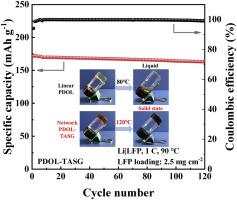揭示高温固态锂金属电池用pdoll基电解质hf诱导降解的机理
IF 14.2
1区 材料科学
Q1 ENGINEERING, MULTIDISCIPLINARY
引用次数: 0
摘要
聚(1,3-二恶烷)基固体聚合物电解质因其高离子电导率和优异的锂阳极相容性在固态锂金属电池(lbs)中受到广泛关注。然而,氢氟酸(HF)在高温下引起的热稳定性差和不可逆降解阻碍了pdoll基电解质的实际应用。在此,我们引入了一种多功能交联剂甘油三缩水甘油酯醚(TASG)来改善电解质的离子电导率和热稳定性。pdoll - tasg稳定的三维网络结构增强了电解质的热稳定性。TASG中的环氧基有效捕获了电解质在高温下产生的HF,防止了PDOL链的不可逆降解。这种捕获将pdoll基电解质的热稳定性从70°C提高到120°C。采用pdl - tasg电解质的lmb在90°C、1C倍率下120次循环后的初始比放电容量为169 mAh g−1,容量保持率为96.4%。即使在100°C下,Li| pdoll - tasg |LFP电池也表现出出色的可循环性,超过了大多数使用固体聚合物电解质的电池。这项工作阐明了hf诱导PDOL降解的机制,并为使用固体聚合物电解质提高lmb的高温耐久性提供了一种策略。本文章由计算机程序翻译,如有差异,请以英文原文为准。

Revealing the mechanism on HF-induced degradation of PDOL-based electrolytes for high-temperature solid-state lithium metal batteries
Poly (1,3-dioxolane)-based (PDOL-based) solid polymer electrolytes have attracted much attention in solid-state lithium metal batteries (LMBs) due to their high ionic conductivity and excellent lithium anode compatibility. However, practical application of PDOL-based electrolytes is hindered by poor thermal stability and irreversible degradation caused by hydrofluoric acid (HF) at high temperatures. Herein, we introduce a multifunctional cross-linking agent glycerol triglycidyl ether (TASG) to improve the ionic conductivity and thermal stability of the electrolyte. The stable three-dimensional network structure of PDOL-TASG enhances the thermal stability of the electrolyte. The epoxy group in TASG effectively captures the HF generated by the electrolyte at high temperatures, preventing irreversible degradation of PDOL chains. This capture elevates the thermal stability of the PDOL-based electrolyte from 70 °C to 120 °C. LMBs employing PDOL-TASG electrolyte demonstrate an initial specific discharge capacity of 169 mAh g−1 with 96.4 % capacity retention after 120 cycles at 90 °C at 1C rate. Even at 100 °C, the Li|PDOL-TASG|LFP batteries demonstrate exceptional cyclability, surpassing most reported batteries using solid polymer electrolytes. This work elucidates the mechanism of HF-induced PDOL degradation and provides a strategy to increase high-temperature durability of LMBs using solid polymer electrolytes.
求助全文
通过发布文献求助,成功后即可免费获取论文全文。
去求助
来源期刊

Composites Part B: Engineering
工程技术-材料科学:复合
CiteScore
24.40
自引率
11.50%
发文量
784
审稿时长
21 days
期刊介绍:
Composites Part B: Engineering is a journal that publishes impactful research of high quality on composite materials. This research is supported by fundamental mechanics and materials science and engineering approaches. The targeted research can cover a wide range of length scales, ranging from nano to micro and meso, and even to the full product and structure level. The journal specifically focuses on engineering applications that involve high performance composites. These applications can range from low volume and high cost to high volume and low cost composite development.
The main goal of the journal is to provide a platform for the prompt publication of original and high quality research. The emphasis is on design, development, modeling, validation, and manufacturing of engineering details and concepts. The journal welcomes both basic research papers and proposals for review articles. Authors are encouraged to address challenges across various application areas. These areas include, but are not limited to, aerospace, automotive, and other surface transportation. The journal also covers energy-related applications, with a focus on renewable energy. Other application areas include infrastructure, off-shore and maritime projects, health care technology, and recreational products.
 求助内容:
求助内容: 应助结果提醒方式:
应助结果提醒方式:


